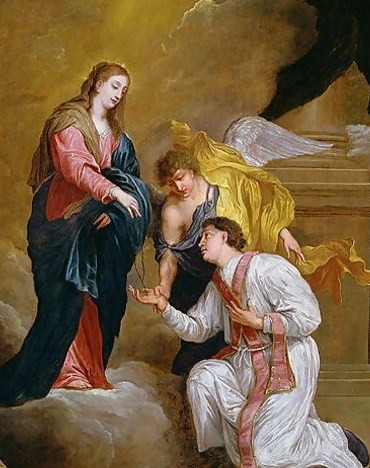Today, we celebrate the commemoration of the Seven Servites, a confraternity of religious men.
On the Feast of the Assumption, August, 15th 1233, these seven young men, with other members of the Laudesi, having confessed and received Holy Communion, were each and all making their thanksgiving after Mass. Each, unknown to those about them, fell into an ecstasy. Each seemed to himself surrounded by supernatural light, in the midst of which Our Lady appeared to them accompanied by angels, who spoke to each of them the words; “Leave the world, retire together into solitude, that you may fight against yourselves, and live wholly for God. You will thus experience heavenly consolations. My protection and assistance will never fail you.”
The vision faded, the congregation dispersed, only the Seven remained, each meditating what the vision might mean. Bonfilius Monaldi, as the eldest, broke the silence, telling what had befallen him, saying he was ready to obey Our Lady’s call. Each recounted the same experiences, and resolve. As Monaldi had been the first to speak, so it was decided that he must be the first to act; they looked to him for guidance. He decided to seek counsel of their director, James of Poggibonsi, who concluded that was no mere fancy of pious youths, but in fact, a call from their Mother, manifesting to them the will of God, to obey without hesitation.
Some of these men were engaged in business, some in offices of state, four had family ties, which it was not easy to break, especially since the Church suffers no married man or woman to enter into religion unless the other party to the marriage contract does so too. It is believed that the two wives who still lived became afterwards Tertiaries of the Order; at any rate the conditions were at the time fulfilled, all social and worldly arrangements were made; and by the eighth of September, the Nativity of the Blessed Virgin, they were free to obey, they had stripped themselves of all that bound them to the world.
Meantime, and while waiting to know the further will of God, Monaldi and their director sketched out a plan of community life. They adopted a habit of gray wool, with a leather cincture, and found a house just outside the city walls, where they might pass much of their time in solitude and prayer, yet near enough to the city to give an example to those they had so lately left. All this was done with the approval of the Bishop; it was merely a question of certain men living a mortified life in community; he granted permission to James to live with them as their chaplain, to celebrate Mass in their oratory, and to reserve the Blessed Sacrament.
Their appearance drew a crowd of sympathizers, who, recognizing their great renunciation and sanctity, pressed to touch their garments, to kiss their hands and entreat their blessing. Suddenly, from the midst of the crowd, were heard the voices of children who cried: “See, the Servants of Mary.” The same exclamation was made still more wonderfully on the following thirteenth of January, when a child only five months old, spoke for the first time in crying said, “Mother, those are Mary’s Servants, give them an alms.” The child’s name was Philip Benizi, who afterwards became one of the greatest Saints of the Order and its superior general.
The community became instrument in helping the Feast of Our Lady of Sorrows to be added to the Church calendar as they prayed often the 7 Sorrows of Mary.
The seven sorrows are as follows: 1 The presentation of Jesus in the temple (when Mary was told a sword would pierce Her Heart); 2 the Flight into Egypt; 3 the Loss of Jesus for three days; 4 Mary meets Jesus on the way of the Cross; 5 Mary stands at the Foot of the Cross; 6 Jesus is taken down from the Cross and placed in Mary’s arms and 7 Jesus is placed into the tomb.
Today, I would like to encourage you to learn and pray the 7 Sorrows of Mary, also called the Servite Rosary. Many special graces are given to those who pray it.



